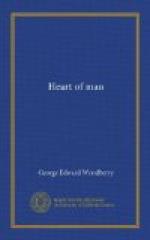The transience of the contents of art may be of two kinds. There is a passing away of error, as there is in all knowledge, but such a loss need not detain attention. What is really in issue is the passing away of the authority of precept and example fitted to one age but not to another, as in the case of the substitution of the ideal of humility for that of valour, owing to a changed emphasis in the scale of virtues. The contents of art, its general ideals, reproduce the successive periods of our earth-history as a race, by generalizing each in its own age. A parallel exists in the subject-matter of the sciences; astronomy, geology, paleontology are similar statements of past phases of the evolution of the earth, its aspects in successive stages. Or, to take a kindred example, just as the planets in their order set forth now the history of our system from nascent life to complete death as earths, so these ideals exhibit man’s stages from savagery to such culture as has been attained. They have more than a descriptive and historical significance; they retain practical vitality because the unchangeable element in the universe and in man’s nature is in the main their subject-matter. It is not merely that the child repeats in his education, in some measure at least, the history of the race, and hence must still learn the value of bravery and humility in their order; nor that in the mass of men many remain ethically and emotionally in the characteristic stages of past culture; but these various ideals of what is admirable have themselves identical elements, and in those points in which they differ respond to native varieties of human capacity and temperament. The living principles of Hebrew, Greek, Roman, and Christian thought and feeling are at work in the world, still formative; it is only by such vitality that their results in art truly survive.
There has been an expansion of the field, and some rearrangement within it; but the evolution of human ideals has been, in our civilization, the growth of one spirit out of its dead selves carrying on into each reincarnation the true life that was in the form it leaves, and which is immortal. The substance in each ideal, its embodiment of what is cardinal in all humanity, remains integral. The alloy of mortality in a work of art lies in so much of it as was limited in truth to time, place, country, race, religion, its specific and contemporary part; so great is this in detail that a strong power of historical imagination, the power to rebuild past conditions, is a main necessity of culture, like the study of a dead language; an interpretative faculty, the power to translate into terms of our knowledge what was stated in terms of different beliefs, must go with this; and also a corrective power, if the work is to be truly useful and enter into our lives with effect. Such an alloy there is in nearly all great works even; much in Homer, something in Virgil, a considerable part of Dante, and an increasing portion in Milton




